2004 CHRYSLER VOYAGER dimensions
[x] Cancel search: dimensionsPage 2235 of 2585
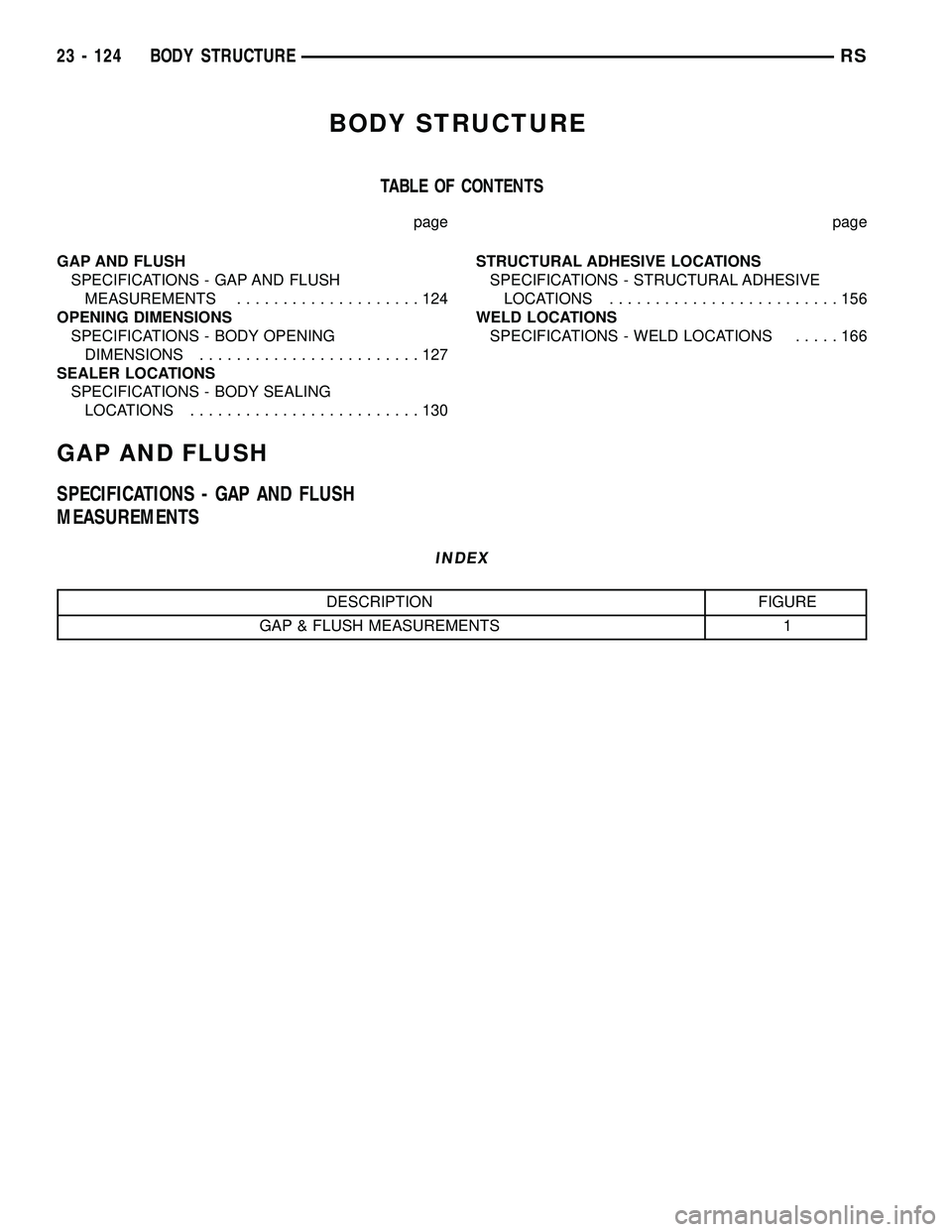
BODY STRUCTURE
TABLE OF CONTENTS
page page
GAP AND FLUSH
SPECIFICATIONS - GAP AND FLUSH
MEASUREMENTS....................124
OPENING DIMENSIONS
SPECIFICATIONS - BODY OPENING
DIMENSIONS........................127
SEALER LOCATIONS
SPECIFICATIONS - BODY SEALING
LOCATIONS.........................130STRUCTURAL ADHESIVE LOCATIONS
SPECIFICATIONS - STRUCTURAL ADHESIVE
LOCATIONS.........................156
WELD LOCATIONS
SPECIFICATIONS - WELD LOCATIONS.....166
GAP AND FLUSH
SPECIFICATIONS - GAP AND FLUSH
MEASUREMENTS
INDEX
DESCRIPTION FIGURE
GAP & FLUSH MEASUREMENTS 1
23 - 124 BODY STRUCTURERS
Page 2238 of 2585
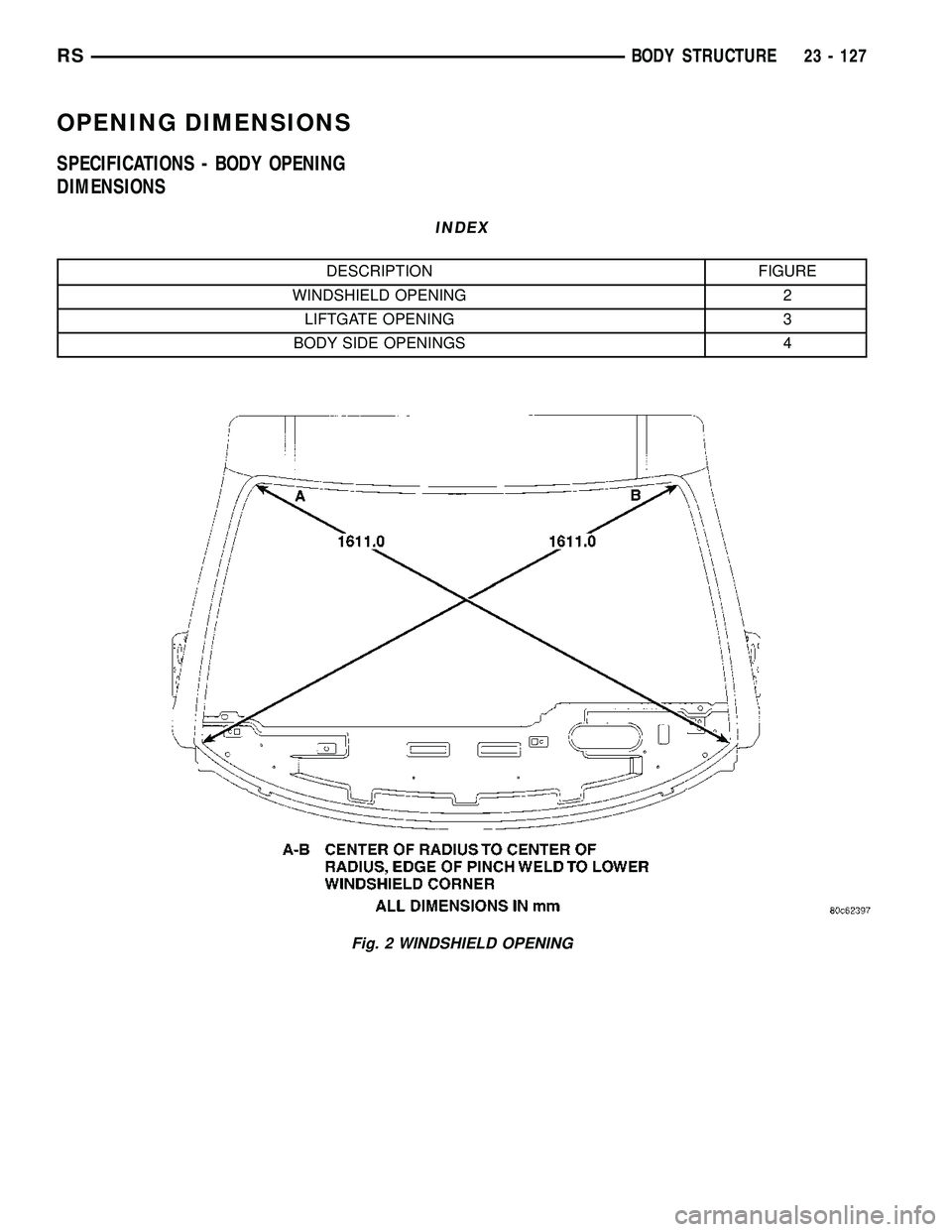
OPENING DIMENSIONS
SPECIFICATIONS - BODY OPENING
DIMENSIONS
INDEX
DESCRIPTION FIGURE
WINDSHIELD OPENING 2
LIFTGATE OPENING 3
BODY SIDE OPENINGS 4
Fig. 2 WINDSHIELD OPENING
RSBODY STRUCTURE23 - 127
Page 2239 of 2585
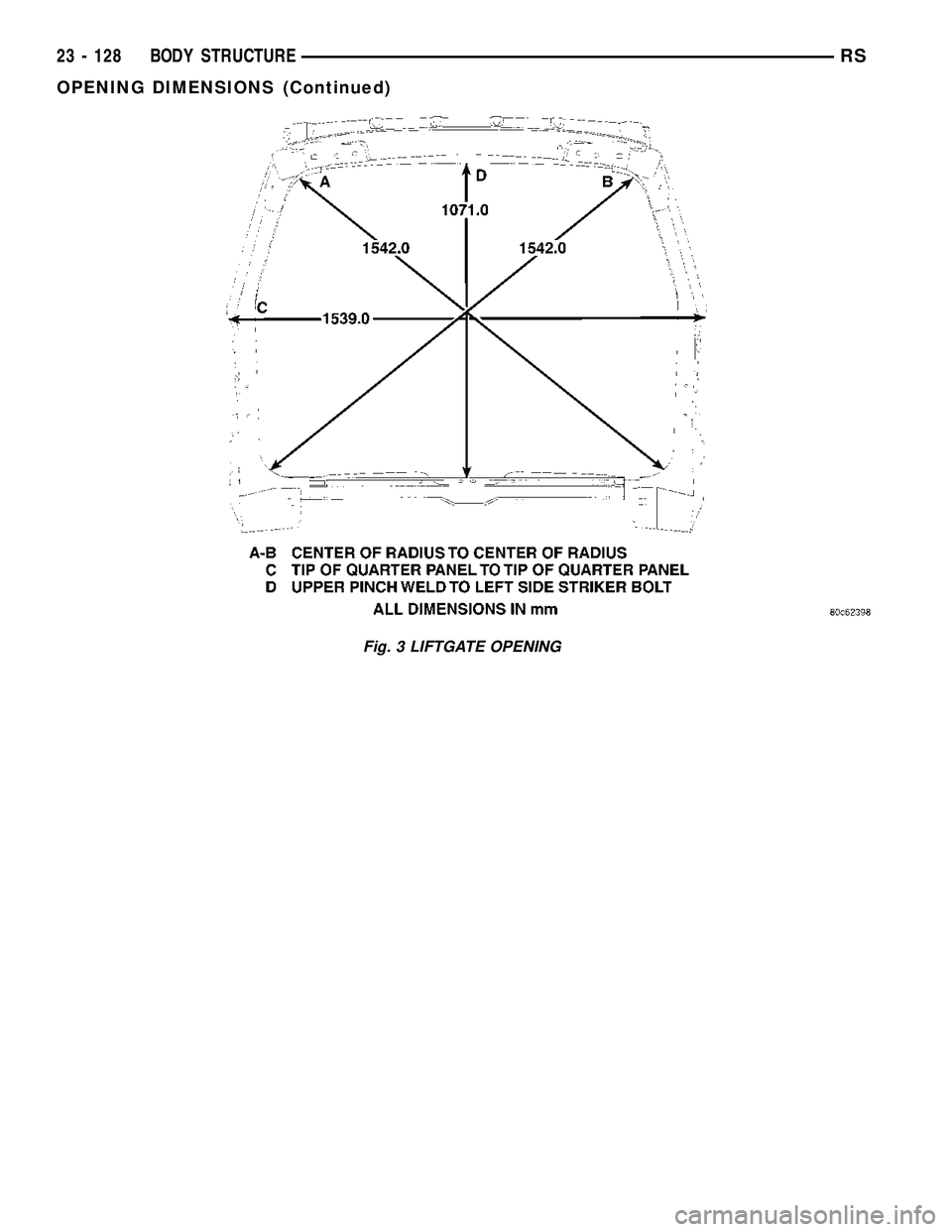
Fig. 3 LIFTGATE OPENING
23 - 128 BODY STRUCTURERS
OPENING DIMENSIONS (Continued)
Page 2240 of 2585
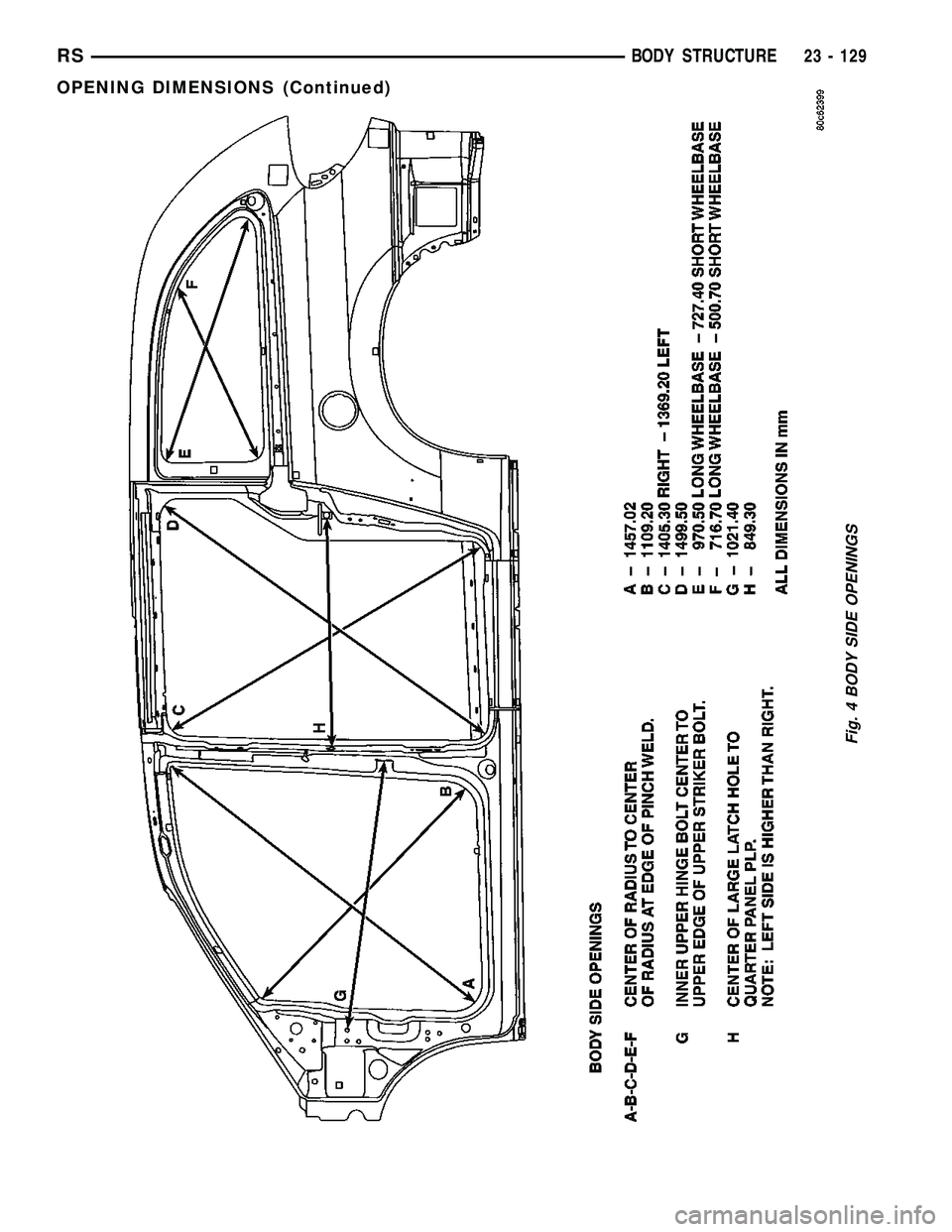
Fig. 4 BODY SIDE OPENINGS
RSBODY STRUCTURE23 - 129
OPENING DIMENSIONS (Continued)
Page 2414 of 2585
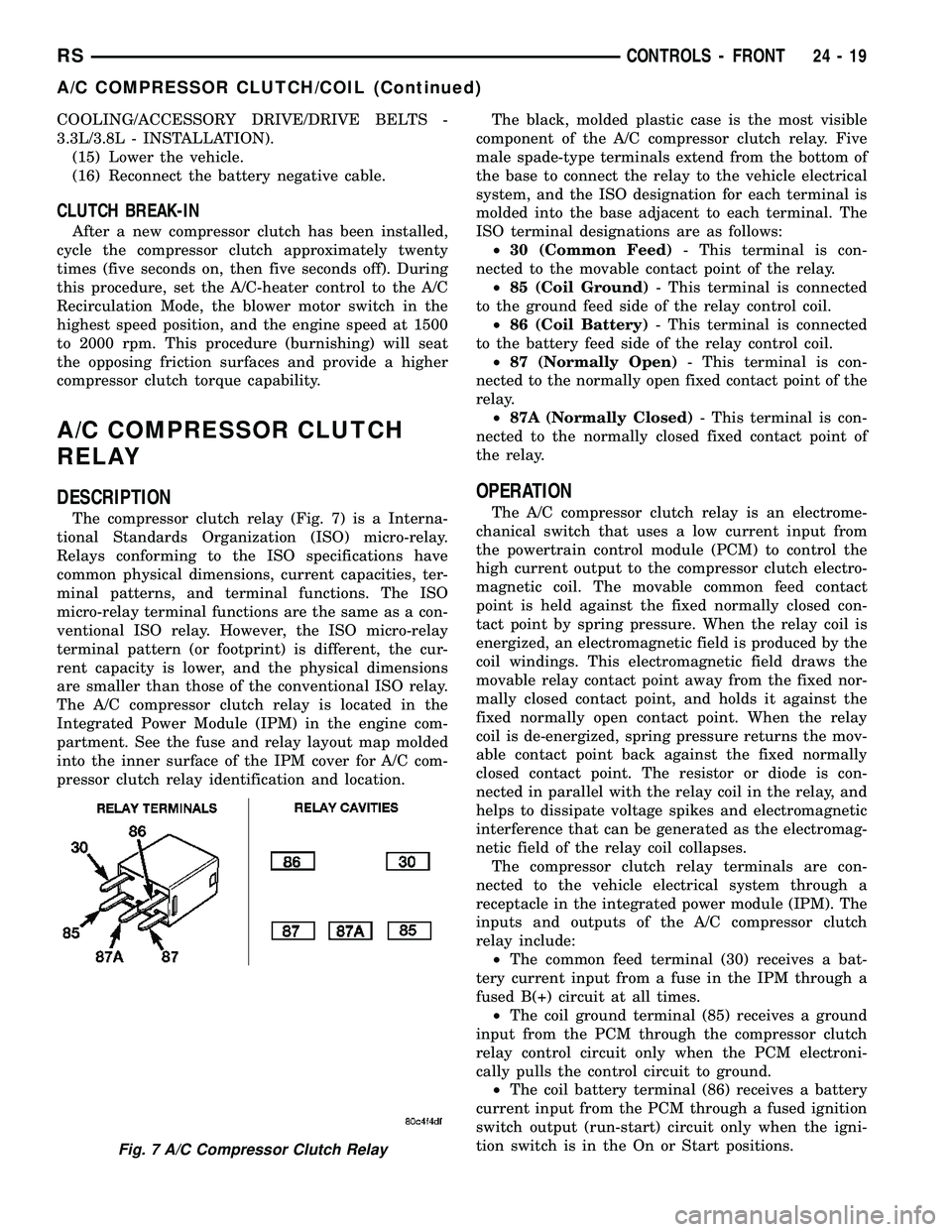
COOLING/ACCESSORY DRIVE/DRIVE BELTS -
3.3L/3.8L - INSTALLATION).
(15) Lower the vehicle.
(16) Reconnect the battery negative cable.
CLUTCH BREAK-IN
After a new compressor clutch has been installed,
cycle the compressor clutch approximately twenty
times (five seconds on, then five seconds off). During
this procedure, set the A/C-heater control to the A/C
Recirculation Mode, the blower motor switch in the
highest speed position, and the engine speed at 1500
to 2000 rpm. This procedure (burnishing) will seat
the opposing friction surfaces and provide a higher
compressor clutch torque capability.
A/C COMPRESSOR CLUTCH
RELAY
DESCRIPTION
The compressor clutch relay (Fig. 7) is a Interna-
tional Standards Organization (ISO) micro-relay.
Relays conforming to the ISO specifications have
common physical dimensions, current capacities, ter-
minal patterns, and terminal functions. The ISO
micro-relay terminal functions are the same as a con-
ventional ISO relay. However, the ISO micro-relay
terminal pattern (or footprint) is different, the cur-
rent capacity is lower, and the physical dimensions
are smaller than those of the conventional ISO relay.
The A/C compressor clutch relay is located in the
Integrated Power Module (IPM) in the engine com-
partment. See the fuse and relay layout map molded
into the inner surface of the IPM cover for A/C com-
pressor clutch relay identification and location.The black, molded plastic case is the most visible
component of the A/C compressor clutch relay. Five
male spade-type terminals extend from the bottom of
the base to connect the relay to the vehicle electrical
system, and the ISO designation for each terminal is
molded into the base adjacent to each terminal. The
ISO terminal designations are as follows:
²30 (Common Feed)- This terminal is con-
nected to the movable contact point of the relay.
²85 (Coil Ground)- This terminal is connected
to the ground feed side of the relay control coil.
²86 (Coil Battery)- This terminal is connected
to the battery feed side of the relay control coil.
²87 (Normally Open)- This terminal is con-
nected to the normally open fixed contact point of the
relay.
²87A (Normally Closed)- This terminal is con-
nected to the normally closed fixed contact point of
the relay.
OPERATION
The A/C compressor clutch relay is an electrome-
chanical switch that uses a low current input from
the powertrain control module (PCM) to control the
high current output to the compressor clutch electro-
magnetic coil. The movable common feed contact
point is held against the fixed normally closed con-
tact point by spring pressure. When the relay coil is
energized, an electromagnetic field is produced by the
coil windings. This electromagnetic field draws the
movable relay contact point away from the fixed nor-
mally closed contact point, and holds it against the
fixed normally open contact point. When the relay
coil is de-energized, spring pressure returns the mov-
able contact point back against the fixed normally
closed contact point. The resistor or diode is con-
nected in parallel with the relay coil in the relay, and
helps to dissipate voltage spikes and electromagnetic
interference that can be generated as the electromag-
netic field of the relay coil collapses.
The compressor clutch relay terminals are con-
nected to the vehicle electrical system through a
receptacle in the integrated power module (IPM). The
inputs and outputs of the A/C compressor clutch
relay include:
²The common feed terminal (30) receives a bat-
tery current input from a fuse in the IPM through a
fused B(+) circuit at all times.
²The coil ground terminal (85) receives a ground
input from the PCM through the compressor clutch
relay control circuit only when the PCM electroni-
cally pulls the control circuit to ground.
²The coil battery terminal (86) receives a battery
current input from the PCM through a fused ignition
switch output (run-start) circuit only when the igni-
tion switch is in the On or Start positions.
Fig. 7 A/C Compressor Clutch Relay
RSCONTROLS - FRONT24-19
A/C COMPRESSOR CLUTCH/COIL (Continued)
Page 2419 of 2585
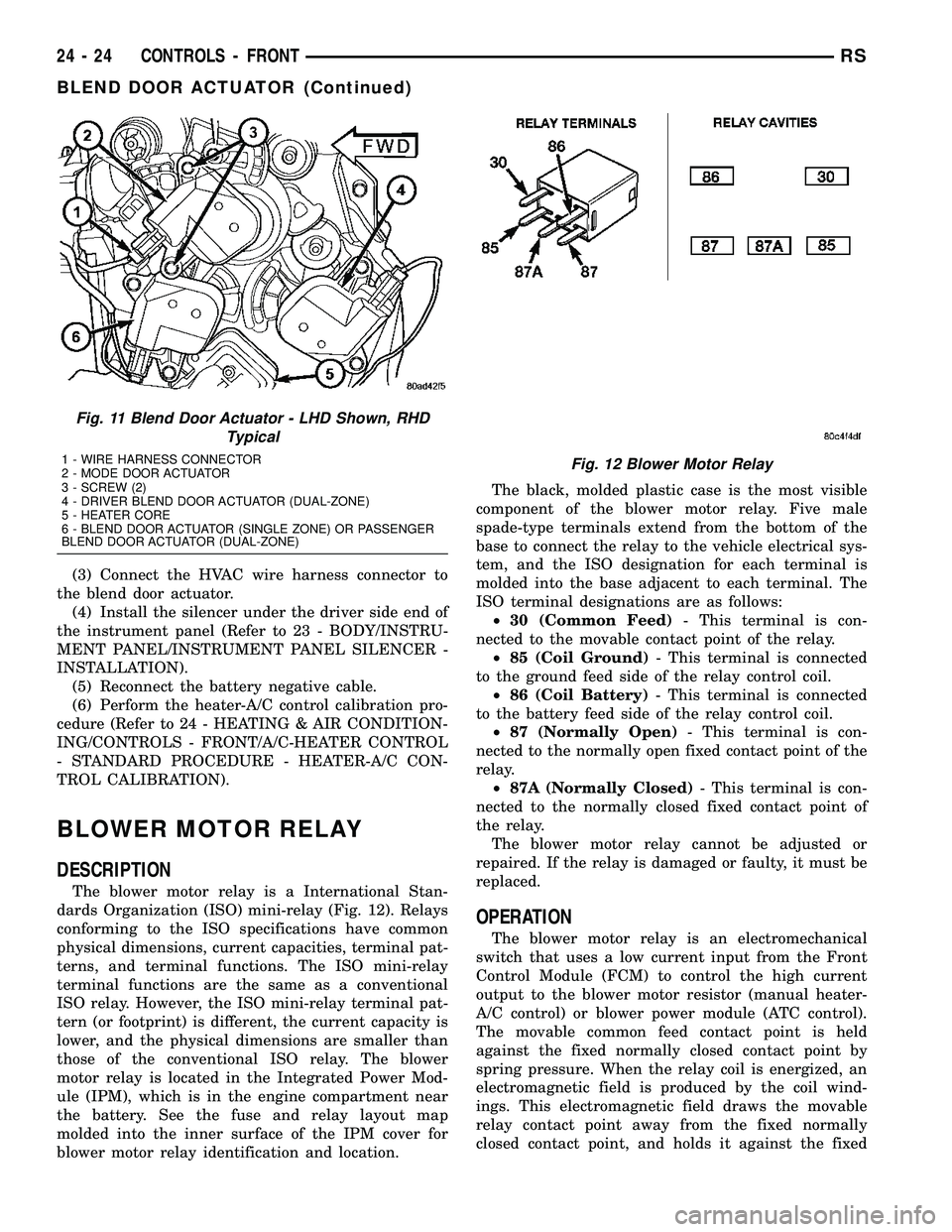
(3) Connect the HVAC wire harness connector to
the blend door actuator.
(4) Install the silencer under the driver side end of
the instrument panel (Refer to 23 - BODY/INSTRU-
MENT PANEL/INSTRUMENT PANEL SILENCER -
INSTALLATION).
(5) Reconnect the battery negative cable.
(6) Perform the heater-A/C control calibration pro-
cedure (Refer to 24 - HEATING & AIR CONDITION-
ING/CONTROLS - FRONT/A/C-HEATER CONTROL
- STANDARD PROCEDURE - HEATER-A/C CON-
TROL CALIBRATION).
BLOWER MOTOR RELAY
DESCRIPTION
The blower motor relay is a International Stan-
dards Organization (ISO) mini-relay (Fig. 12). Relays
conforming to the ISO specifications have common
physical dimensions, current capacities, terminal pat-
terns, and terminal functions. The ISO mini-relay
terminal functions are the same as a conventional
ISO relay. However, the ISO mini-relay terminal pat-
tern (or footprint) is different, the current capacity is
lower, and the physical dimensions are smaller than
those of the conventional ISO relay. The blower
motor relay is located in the Integrated Power Mod-
ule (IPM), which is in the engine compartment near
the battery. See the fuse and relay layout map
molded into the inner surface of the IPM cover for
blower motor relay identification and location.The black, molded plastic case is the most visible
component of the blower motor relay. Five male
spade-type terminals extend from the bottom of the
base to connect the relay to the vehicle electrical sys-
tem, and the ISO designation for each terminal is
molded into the base adjacent to each terminal. The
ISO terminal designations are as follows:
²30 (Common Feed)- This terminal is con-
nected to the movable contact point of the relay.
²85 (Coil Ground)- This terminal is connected
to the ground feed side of the relay control coil.
²86 (Coil Battery)- This terminal is connected
to the battery feed side of the relay control coil.
²87 (Normally Open)- This terminal is con-
nected to the normally open fixed contact point of the
relay.
²87A (Normally Closed)- This terminal is con-
nected to the normally closed fixed contact point of
the relay.
The blower motor relay cannot be adjusted or
repaired. If the relay is damaged or faulty, it must be
replaced.
OPERATION
The blower motor relay is an electromechanical
switch that uses a low current input from the Front
Control Module (FCM) to control the high current
output to the blower motor resistor (manual heater-
A/C control) or blower power module (ATC control).
The movable common feed contact point is held
against the fixed normally closed contact point by
spring pressure. When the relay coil is energized, an
electromagnetic field is produced by the coil wind-
ings. This electromagnetic field draws the movable
relay contact point away from the fixed normally
closed contact point, and holds it against the fixed
Fig. 11 Blend Door Actuator - LHD Shown, RHD
Typical
1 - WIRE HARNESS CONNECTOR
2 - MODE DOOR ACTUATOR
3 - SCREW (2)
4 - DRIVER BLEND DOOR ACTUATOR (DUAL-ZONE)
5 - HEATER CORE
6 - BLEND DOOR ACTUATOR (SINGLE ZONE) OR PASSENGER
BLEND DOOR ACTUATOR (DUAL-ZONE)Fig. 12 Blower Motor Relay
24 - 24 CONTROLS - FRONTRS
BLEND DOOR ACTUATOR (Continued)
Page 2432 of 2585
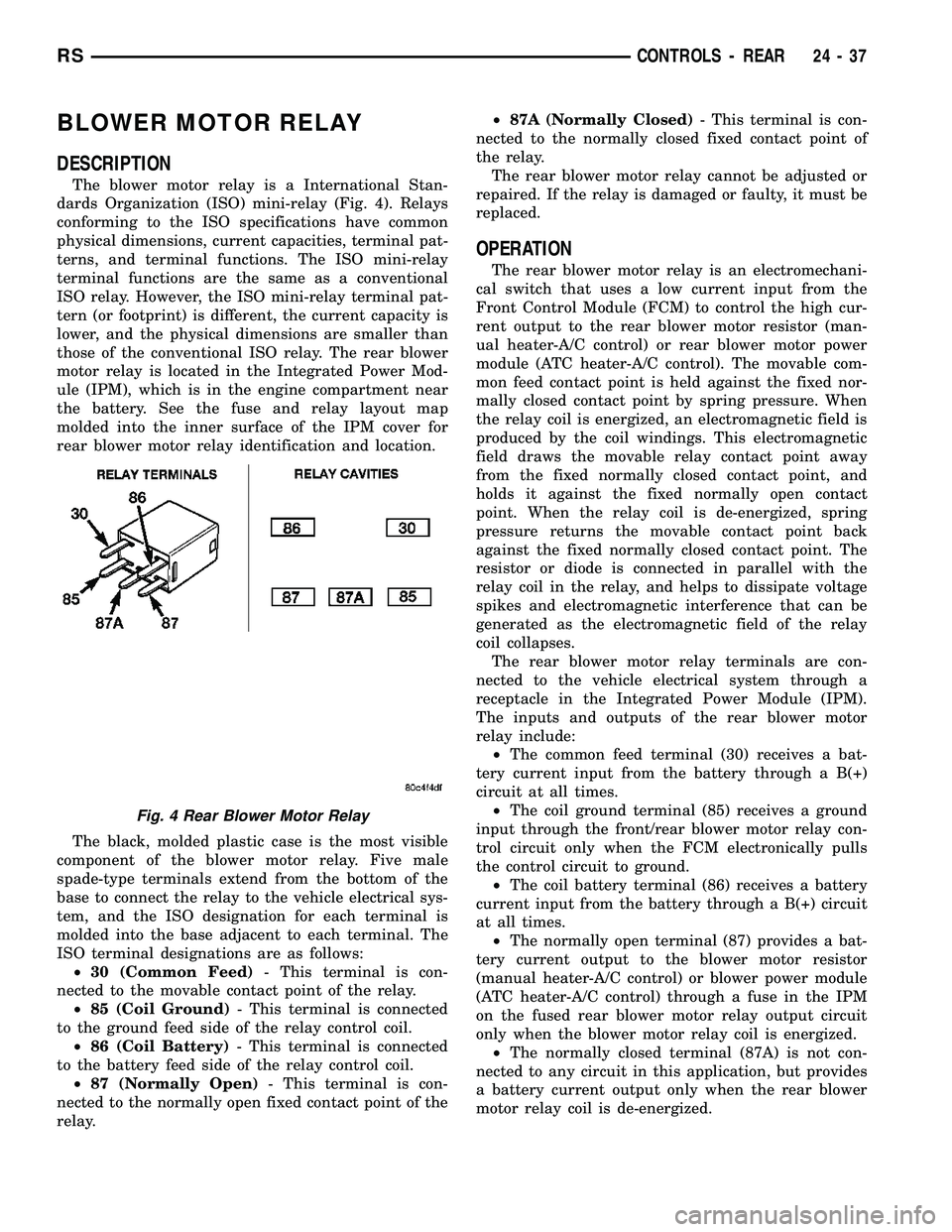
BLOWER MOTOR RELAY
DESCRIPTION
The blower motor relay is a International Stan-
dards Organization (ISO) mini-relay (Fig. 4). Relays
conforming to the ISO specifications have common
physical dimensions, current capacities, terminal pat-
terns, and terminal functions. The ISO mini-relay
terminal functions are the same as a conventional
ISO relay. However, the ISO mini-relay terminal pat-
tern (or footprint) is different, the current capacity is
lower, and the physical dimensions are smaller than
those of the conventional ISO relay. The rear blower
motor relay is located in the Integrated Power Mod-
ule (IPM), which is in the engine compartment near
the battery. See the fuse and relay layout map
molded into the inner surface of the IPM cover for
rear blower motor relay identification and location.
The black, molded plastic case is the most visible
component of the blower motor relay. Five male
spade-type terminals extend from the bottom of the
base to connect the relay to the vehicle electrical sys-
tem, and the ISO designation for each terminal is
molded into the base adjacent to each terminal. The
ISO terminal designations are as follows:
²30 (Common Feed)- This terminal is con-
nected to the movable contact point of the relay.
²85 (Coil Ground)- This terminal is connected
to the ground feed side of the relay control coil.
²86 (Coil Battery)- This terminal is connected
to the battery feed side of the relay control coil.
²87 (Normally Open)- This terminal is con-
nected to the normally open fixed contact point of the
relay.²87A (Normally Closed)- This terminal is con-
nected to the normally closed fixed contact point of
the relay.
The rear blower motor relay cannot be adjusted or
repaired. If the relay is damaged or faulty, it must be
replaced.
OPERATION
The rear blower motor relay is an electromechani-
cal switch that uses a low current input from the
Front Control Module (FCM) to control the high cur-
rent output to the rear blower motor resistor (man-
ual heater-A/C control) or rear blower motor power
module (ATC heater-A/C control). The movable com-
mon feed contact point is held against the fixed nor-
mally closed contact point by spring pressure. When
the relay coil is energized, an electromagnetic field is
produced by the coil windings. This electromagnetic
field draws the movable relay contact point away
from the fixed normally closed contact point, and
holds it against the fixed normally open contact
point. When the relay coil is de-energized, spring
pressure returns the movable contact point back
against the fixed normally closed contact point. The
resistor or diode is connected in parallel with the
relay coil in the relay, and helps to dissipate voltage
spikes and electromagnetic interference that can be
generated as the electromagnetic field of the relay
coil collapses.
The rear blower motor relay terminals are con-
nected to the vehicle electrical system through a
receptacle in the Integrated Power Module (IPM).
The inputs and outputs of the rear blower motor
relay include:
²The common feed terminal (30) receives a bat-
tery current input from the battery through a B(+)
circuit at all times.
²The coil ground terminal (85) receives a ground
input through the front/rear blower motor relay con-
trol circuit only when the FCM electronically pulls
the control circuit to ground.
²The coil battery terminal (86) receives a battery
current input from the battery through a B(+) circuit
at all times.
²The normally open terminal (87) provides a bat-
tery current output to the blower motor resistor
(manual heater-A/C control) or blower power module
(ATC heater-A/C control) through a fuse in the IPM
on the fused rear blower motor relay output circuit
only when the blower motor relay coil is energized.
²The normally closed terminal (87A) is not con-
nected to any circuit in this application, but provides
a battery current output only when the rear blower
motor relay coil is de-energized.
Fig. 4 Rear Blower Motor Relay
RSCONTROLS - REAR24-37
Page 2547 of 2585
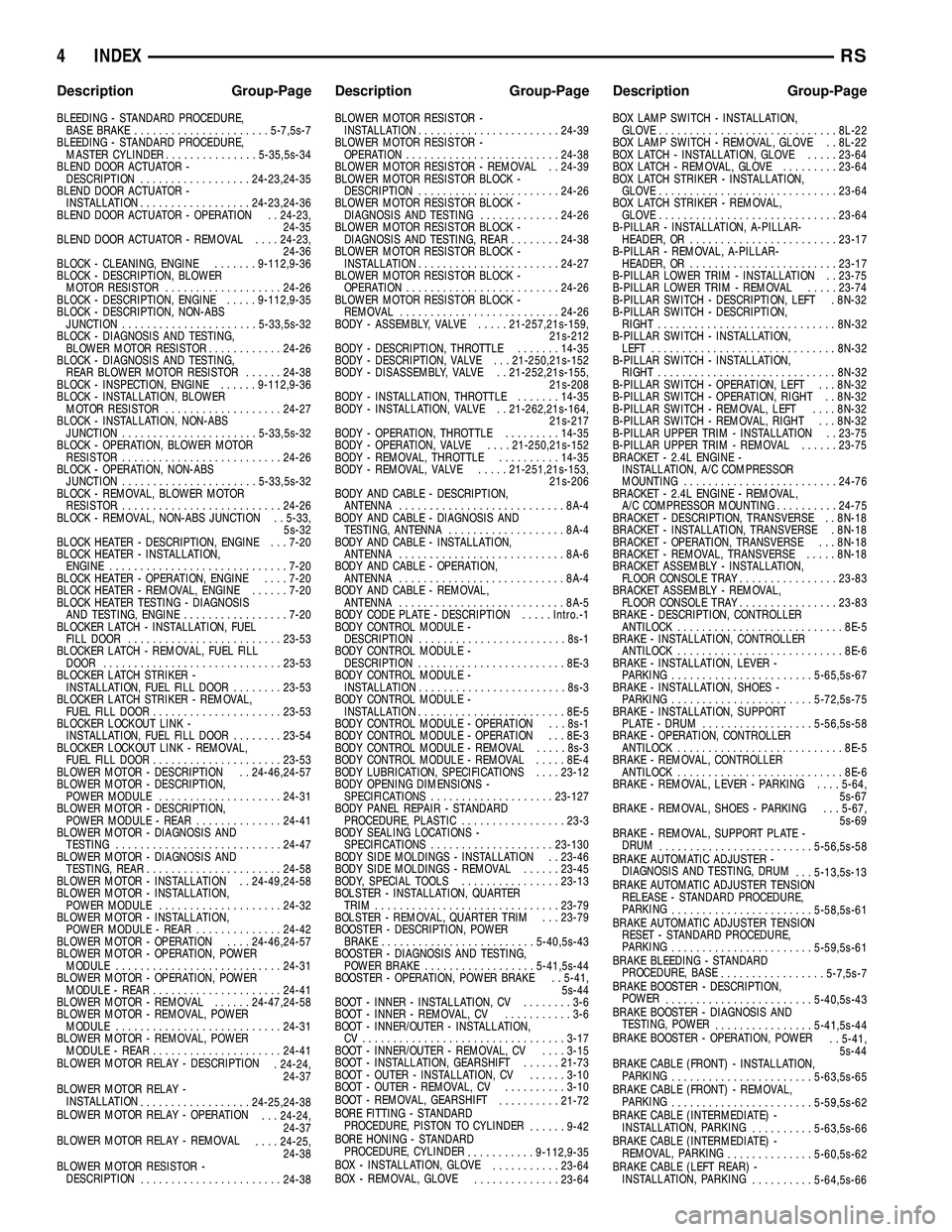
BLEEDING - STANDARD PROCEDURE,
BASE BRAKE......................5-7,5s-7
BLEEDING - STANDARD PROCEDURE,
MASTER CYLINDER...............5-35,5s-34
BLEND DOOR ACTUATOR -
DESCRIPTION..................24-23,24-35
BLEND DOOR ACTUATOR -
INSTALLATION..................24-23,24-36
BLEND DOOR ACTUATOR - OPERATION . . 24-23,
24-35
BLEND DOOR ACTUATOR - REMOVAL....24-23,
24-36
BLOCK - CLEANING, ENGINE.......9-112,9-36
BLOCK - DESCRIPTION, BLOWER
MOTOR RESISTOR...................24-26
BLOCK - DESCRIPTION, ENGINE.....9-112,9-35
BLOCK - DESCRIPTION, NON-ABS
JUNCTION......................5-33,5s-32
BLOCK - DIAGNOSIS AND TESTING,
BLOWER MOTOR RESISTOR............24-26
BLOCK - DIAGNOSIS AND TESTING,
REAR BLOWER MOTOR RESISTOR......24-38
BLOCK - INSPECTION, ENGINE......9-112,9-36
BLOCK - INSTALLATION, BLOWER
MOTOR RESISTOR...................24-27
BLOCK - INSTALLATION, NON-ABS
JUNCTION......................5-33,5s-32
BLOCK - OPERATION, BLOWER MOTOR
RESISTOR..........................24-26
BLOCK - OPERATION, NON-ABS
JUNCTION......................5-33,5s-32
BLOCK - REMOVAL, BLOWER MOTOR
RESISTOR...........................24-26
BLOCK - REMOVAL, NON-ABS JUNCTION . . 5-33,
5s-32
BLOCK HEATER - DESCRIPTION, ENGINE . . . 7-20
BLOCK HEATER - INSTALLATION,
ENGINE.............................7-20
BLOCK HEATER - OPERATION, ENGINE....7-20
BLOCK HEATER - REMOVAL, ENGINE......7-20
BLOCK HEATER TESTING - DIAGNOSIS
AND TESTING, ENGINE.................7-20
BLOCKER LATCH - INSTALLATION, FUEL
FILL DOOR.........................23-53
BLOCKER LATCH - REMOVAL, FUEL FILL
DOOR.............................23-53
BLOCKER LATCH STRIKER -
INSTALLATION, FUEL FILL DOOR........23-53
BLOCKER LATCH STRIKER - REMOVAL,
FUEL FILL DOOR.....................23-53
BLOCKER LOCKOUT LINK -
INSTALLATION, FUEL FILL DOOR........23-54
BLOCKER LOCKOUT LINK - REMOVAL,
FUEL FILL DOOR.....................23-53
BLOWER MOTOR - DESCRIPTION . . 24-46,24-57
BLOWER MOTOR - DESCRIPTION,
POWER MODULE....................24-31
BLOWER MOTOR - DESCRIPTION,
POWER MODULE - REAR..............24-41
BLOWER MOTOR - DIAGNOSIS AND
TESTING...........................24-47
BLOWER MOTOR - DIAGNOSIS AND
TESTING, REAR......................24-58
BLOWER MOTOR - INSTALLATION . . 24-49,24-58
BLOWER MOTOR - INSTALLATION,
POWER MODULE....................24-32
BLOWER MOTOR - INSTALLATION,
POWER MODULE - REAR..............24-42
BLOWER MOTOR - OPERATION....24-46,24-57
BLOWER MOTOR - OPERATION, POWER
MODULE...........................24-31
BLOWER MOTOR - OPERATION, POWER
MODULE - REAR.....................24-41
BLOWER MOTOR - REMOVAL......24-47,24-58
BLOWER MOTOR - REMOVAL, POWER
MODULE...........................24-31
BLOWER MOTOR - REMOVAL, POWER
MODULE - REAR.....................24-41
BLOWER MOTOR RELAY - DESCRIPTION
. 24-24,
24-37
BLOWER MOTOR RELAY -
INSTALLATION
..................24-25,24-38
BLOWER MOTOR RELAY - OPERATION
. . . 24-24,
24-37
BLOWER MOTOR RELAY - REMOVAL
....24-25,
24-38
BLOWER MOTOR RESISTOR -
DESCRIPTION
.......................24-38BLOWER MOTOR RESISTOR -
INSTALLATION.......................24-39
BLOWER MOTOR RESISTOR -
OPERATION.........................24-38
BLOWER MOTOR RESISTOR - REMOVAL . . 24-39
BLOWER MOTOR RESISTOR BLOCK -
DESCRIPTION.......................24-26
BLOWER MOTOR RESISTOR BLOCK -
DIAGNOSIS AND TESTING.............24-26
BLOWER MOTOR RESISTOR BLOCK -
DIAGNOSIS AND TESTING, REAR........24-38
BLOWER MOTOR RESISTOR BLOCK -
INSTALLATION.......................24-27
BLOWER MOTOR RESISTOR BLOCK -
OPERATION.........................24-26
BLOWER MOTOR RESISTOR BLOCK -
REMOVAL..........................24-26
BODY - ASSEMBLY, VALVE.....21-257,21s-159,
21s-212
BODY - DESCRIPTION, THROTTLE.......14-35
BODY - DESCRIPTION, VALVE . . . 21-250,21s-152
BODY - DISASSEMBLY, VALVE . . 21-252,21s-155,
21s-208
BODY - INSTALLATION, THROTTLE.......14-35
BODY - INSTALLATION, VALVE . . 21-262,21s-164,
21s-217
BODY - OPERATION, THROTTLE.........14-35
BODY - OPERATION, VALVE....21-250,21s-152
BODY - REMOVAL, THROTTLE..........14-35
BODY - REMOVAL, VALVE.....21-251,21s-153,
21s-206
BODY AND CABLE - DESCRIPTION,
ANTENNA...........................8A-4
BODY AND CABLE - DIAGNOSIS AND
TESTING, ANTENNA...................8A-4
BODY AND CABLE - INSTALLATION,
ANTENNA...........................8A-6
BODY AND CABLE - OPERATION,
ANTENNA...........................8A-4
BODY AND CABLE - REMOVAL,
ANTENNA...........................8A-5
BODY CODE PLATE - DESCRIPTION.....Intro.-1
BODY CONTROL MODULE -
DESCRIPTION........................8s-1
BODY CONTROL MODULE -
DESCRIPTION........................8E-3
BODY CONTROL MODULE -
INSTALLATION........................8s-3
BODY CONTROL MODULE -
INSTALLATION........................8E-5
BODY CONTROL MODULE - OPERATION . . . 8s-1
BODY CONTROL MODULE - OPERATION . . . 8E-3
BODY CONTROL MODULE - REMOVAL.....8s-3
BODY CONTROL MODULE - REMOVAL.....8E-4
BODY LUBRICATION, SPECIFICATIONS....23-12
BODY OPENING DIMENSIONS -
SPECIFICATIONS....................23-127
BODY PANEL REPAIR - STANDARD
PROCEDURE, PLASTIC.................23-3
BODY SEALING LOCATIONS -
SPECIFICATIONS....................23-130
BODY SIDE MOLDINGS - INSTALLATION . . 23-46
BODY SIDE MOLDINGS - REMOVAL......23-45
BODY, SPECIAL TOOLS................23-13
BOLSTER - INSTALLATION, QUARTER
TRIM..............................23-79
BOLSTER - REMOVAL, QUARTER TRIM . . . 23-79
BOOSTER - DESCRIPTION, POWER
BRAKE.........................5-40,5s-43
BOOSTER - DIAGNOSIS AND TESTING,
POWER BRAKE..................5-41,5s-44
BOOSTER - OPERATION, POWER BRAKE . . 5-41,
5s-44
BOOT - INNER - INSTALLATION, CV........3-6
BOOT - INNER - REMOVAL, CV...........3-6
BOOT - INNER/OUTER - INSTALLATION,
CV .................................3-17
BOOT - INNER/OUTER - REMOVAL, CV....3-15
BOOT - INSTALLATION, GEARSHIFT......21-73
BOOT - OUTER - INSTALLATION, CV......3-10
BOOT - OUTER - REMOVAL, CV..........3-10
BOOT - REMOVAL, GEARSHIFT
..........21-72
BORE FITTING - STANDARD
PROCEDURE, PISTON TO CYLINDER
......9-42
BORE HONING - STANDARD
PROCEDURE, CYLINDER
...........9-112,9-35
BOX - INSTALLATION, GLOVE
...........23-64
BOX - REMOVAL, GLOVE
..............23-64BOX LAMP SWITCH - INSTALLATION,
GLOVE.............................8L-22
BOX LAMP SWITCH - REMOVAL, GLOVE . . 8L-22
BOX LATCH - INSTALLATION, GLOVE.....23-64
BOX LATCH - REMOVAL, GLOVE.........23-64
BOX LATCH STRIKER - INSTALLATION,
GLOVE.............................23-64
BOX LATCH STRIKER - REMOVAL,
GLOVE.............................23-64
B-PILLAR - INSTALLATION, A-PILLAR-
HEADER, OR........................23-17
B-PILLAR - REMOVAL, A-PILLAR-
HEADER, OR........................23-17
B-PILLAR LOWER TRIM - INSTALLATION . . 23-75
B-PILLAR LOWER TRIM - REMOVAL.....23-74
B-PILLAR SWITCH - DESCRIPTION, LEFT . 8N-32
B-PILLAR SWITCH - DESCRIPTION,
RIGHT.............................8N-32
B-PILLAR SWITCH - INSTALLATION,
LEFT..............................8N-32
B-PILLAR SWITCH - INSTALLATION,
RIGHT.............................8N-32
B-PILLAR SWITCH - OPERATION, LEFT . . . 8N-32
B-PILLAR SWITCH - OPERATION, RIGHT . . 8N-32
B-PILLAR SWITCH - REMOVAL, LEFT....8N-32
B-PILLAR SWITCH - REMOVAL, RIGHT . . . 8N-32
B-PILLAR UPPER TRIM - INSTALLATION . . 23-75
B-PILLAR UPPER TRIM - REMOVAL......23-75
BRACKET - 2.4L ENGINE -
INSTALLATION, A/C COMPRESSOR
MOUNTING.........................24-76
BRACKET - 2.4L ENGINE - REMOVAL,
A/C COMPRESSOR MOUNTING..........24-75
BRACKET - DESCRIPTION, TRANSVERSE . . 8N-18
BRACKET - INSTALLATION, TRANSVERSE . 8N-18
BRACKET - OPERATION, TRANSVERSE . . . 8N-18
BRACKET - REMOVAL, TRANSVERSE.....8N-18
BRACKET ASSEMBLY - INSTALLATION,
FLOOR CONSOLE TRAY................23-83
BRACKET ASSEMBLY - REMOVAL,
FLOOR CONSOLE TRAY................23-83
BRAKE - DESCRIPTION, CONTROLLER
ANTILOCK...........................8E-5
BRAKE - INSTALLATION, CONTROLLER
ANTILOCK...........................8E-6
BRAKE - INSTALLATION, LEVER -
PARKING.......................5-65,5s-67
BRAKE - INSTALLATION, SHOES -
PARKING.......................5-72,5s-75
BRAKE - INSTALLATION, SUPPORT
PLATE - DRUM..................5-56,5s-58
BRAKE - OPERATION, CONTROLLER
ANTILOCK...........................8E-5
BRAKE - REMOVAL, CONTROLLER
ANTILOCK...........................8E-6
BRAKE - REMOVAL, LEVER - PARKING....5-64,
5s-67
BRAKE - REMOVAL, SHOES - PARKING . . . 5-67,
5s-69
BRAKE - REMOVAL, SUPPORT PLATE -
DRUM
.........................5-56,5s-58
BRAKE AUTOMATIC ADJUSTER -
DIAGNOSIS AND TESTING, DRUM
. . . 5-13,5s-13
BRAKE AUTOMATIC ADJUSTER TENSION
RELEASE - STANDARD PROCEDURE,
PARKING
.......................5-58,5s-61
BRAKE AUTOMATIC ADJUSTER TENSION
RESET - STANDARD PROCEDURE,
PARKING
.......................5-59,5s-61
BRAKE BLEEDING - STANDARD
PROCEDURE, BASE
.................5-7,5s-7
BRAKE BOOSTER - DESCRIPTION,
POWER
........................5-40,5s-43
BRAKE BOOSTER - DIAGNOSIS AND
TESTING, POWER
................5-41,5s-44
BRAKE BOOSTER - OPERATION, POWER
. . 5-41,
5s-44
BRAKE CABLE (FRONT) - INSTALLATION,
PARKING
.......................5-63,5s-65
BRAKE CABLE (FRONT) - REMOVAL,
PARKING
.......................5-59,5s-62
BRAKE CABLE (INTERMEDIATE) -
INSTALLATION, PARKING
..........5-63,5s-66
BRAKE CABLE (INTERMEDIATE) -
REMOVAL, PARKING
..............5-60,5s-62
BRAKE CABLE (LEFT REAR) -
INSTALLATION, PARKING
..........5-64,5s-66
4 INDEXRS
Description Group-Page Description Group-Page Description Group-Page